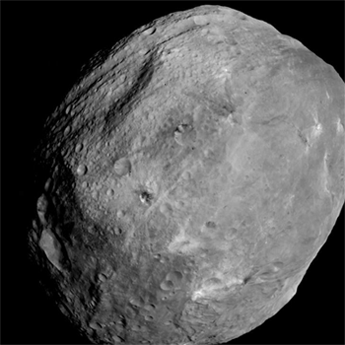Asteroid Vesta has revealed itself as colorful, diverse – and even older than our Earth — in the first-ever orbit of an object in the asteroid belt by a space probe. NASA’s Dawn mission orbits the massive asteroid Vesta through August of 2012. Carol Raymond is the Deputy Principal Investigator of the Dawn space mission. She announced early Dawn findings at a May 2012 press conference from NASA headquarters. She told EarthSky:

Dawn’s data have allowed the history of Vesta to be defined. It formed within two million years after the first solids formed in the solar system — before Ceres formed, before the terrestrial planets formed.
Scientists consider asteroid Vesta to be a protoplanet, one of roughly a hundred space seeds that clumped together from dust and other space rocks to eventually grow and form the planets. Raymond said:
We now know that Vesta is the only intact, layered planetary building block surviving the very earliest days of the solar system.
Here’s more about the landscape of Vesta: Dawn spacecraft reveals landscape of Vesta
This early data show asteroid Vesta to be like a three-layer cake, with a concentrated iron core, a silicate mantle, and a thin crust of basalt. In this way, she said, it’s like the Earth, the moon, Mercury, and Mars. What’s more, about one in twenty meteorites are now confirmed to be pieces of Vesta. These meteorites result from a gigantic collision that left a crater on Vesta the size of the main island of Hawaii. Raymond told EarthSky:
Vesta is special because it survived the intense collisional environment of the main asteroid belt for billion of years, allowing us to interrogate a key witness to the events at the very beginning of the solar system.
Listen to the 90-second EarthSky interview with Carol Raymond on asteroid Vesta, at the top of the page.











